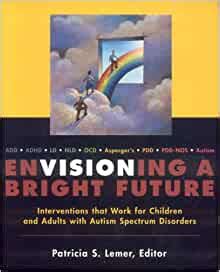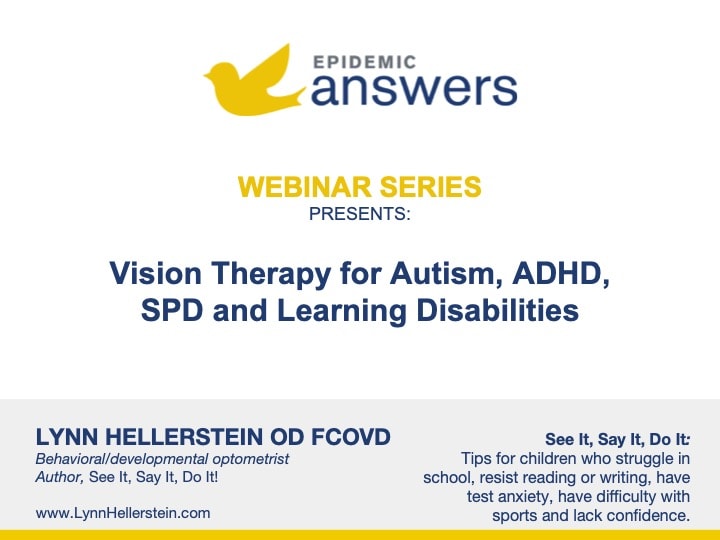This article is adapted from materials provided by OEP, COVD and Your Child’s Vision by Richard S. Kavner. Dr. Irwin Suchoff, editor of the Journal of Behavioral Optometry (JBO), contributed to this article. Strabismus and amblyopia are visual conditions that affect the ability of the eyes and the brain to communicate. In a 1999 study by Dr. Melvin Kaplan, 17 of 34 children with autism had a strabismus.
What Happens Normally?
As we scan our environment, not only must our two eyes simultaneously aim at the same object, but our brains must integrate a message from each eye into a single image. The process of fusion (combining the pictures from each eye into a single picture) enables us to perceive three-dimensional depth and helps us to determine our relationships to objects in our environment. Vision emerges as the primary sense when a typical child integrates it with touch, movement and the other senses.
What Goes Wrong?
In children with developmental delays, signs of incomplete or inefficient eye teaming (binocularity) usually appear around eighteen months, just when expressive language is emerging. However, later onset is not uncommon. Poor eye teaming can be associated with neurological disturbances related to heavy metal toxicity, high fevers and childhood illnesses such as strep or pneumonia.
Initially, the inability to efficiently and effectively team the eyes may appear only at times of illness, fatigue or intense concentration. However, frequently, the vulnerable binocularity can worsen and strabismus and amblyopia can result.
First, Strabismus…
In strabismus, commonly known as crossed or wall eyes, a person’s eyes are not aligned. One eye accurately aims at the object of regard while the other eye misses it by aiming above, below or to the left or right of it. Double vision (diplopia) then results. The misalignment may be constant or intermittent, and thus not always noticeable. Disorganization and confusion follow as the brain struggles to integrate competing messages.
Next, Amblyopia…
In order to minimize the disorganization and confusion, sometimes the unconscious mind adapts to strabismus by suppressing signals from the faulty aiming eye. Eventually, visual suppression leads to amblyopia or “lazy eye,” in which the nerves that transport and interpret visual information lose some of their ability. The result is poor vision in one eye, due to an interference in the neurological interpretive mechanism.
In many instances the reduced vision cannot be corrected with glasses or surgery. With the eyes functioning at less than 100% efficiency, any sustained visual activity such as reading may require extra effort and strain. As in strabismus, the only obvious sign of amblyopia may be an eye turn. However, some people with amblyopia may turn their heads to see certain things or close one eye when reading.
Strabismus and Amblyopia Affect Spatial Relations and Balance
The cosmetic aspect of misalignment is obvious. Even more important are the effects on function and vision. Strabismus can disrupt the ability to orient oneself in space. A good number of the eye’s neural fibers bring information to the body’s balance system. If they deliver inaccurate information, the person’s sense of where he is in space can be compromised.
The Psychological Effects of Strabismus
Strabismus and double vision can adversely affect social-emotional development. A child who is disoriented in space experiences himself and his environment as unstable and unpredictable. He may grow increasingly inward, become belligerent or demonstrate sensory defensiveness. Does this sound hauntingly similar to “autism?”
Treatment and Referral
Strabismus and amblyopia always require attention. These conditions rarely go away untreated; nor do children outgrow them. Surgery may cosmetically straighten the eyes but usually does not improve visual function, especially without pre- and post-surgical vision therapy.
Patching the non-amblyopic eye to force the amblyopic eye to see is also of limited value without vision therapy. Effective treatment programs combine usually involve lenses, prisms and motor activity as part of vision therapy to teach the eyes, body and brain to work together.
Research shows that vision therapy can be effective at any age, but more treatment is needed the longer the condition has existed. Proper early childhood examinations are essential since many patients with amblyopia are unaware that their vision is aberrant until they undergo a screening.
Untreated binocular vision problems can pose obstacles to the effective treatment of sensory integration and speech-language disorders and other developmental delays. Professionals treating children with autism, learning and behavioral issues, especially occupational and speech/language therapists, must be alert to signs of poor binocularity so that they can make an appropriate referral.
If you suspect that a child’s eyes don¹t work together, go to www.covd.org to find a qualified eye care practitioner in your area.
Still Looking for Answers?
Visit the Epidemic Answers Practitioner Directory to find a practitioner near you.
Join us inside our online membership community for parents, Healing Together, where you’ll find even more healing resources, expert guidance, and a community to support you every step of your child’s healing journey.
Sources & References
Kaplan, M., et al. Strabismus in Autism Spectrum Disorder. Focus on Autism and Other Developmental Disabilities. 1999.
Khanna, R.K., et al. Ophthalmological findings in children with autism spectrum disorder. Graefes Arch Clin Exp Ophthalmol. 2020 Apr;258(4):909-916.
Little, J.A. Vision in children with autism spectrum disorder: a critical review. Clin Exp Optom. 2018 Jul;101(4):504-513.
Resources
Books
Hellerstein, Lynn. 50 Tips to Improve Your Sports Performance. HiClear Publishing LLC, 2013.
Hellerstein, Lynn. Expand Your Vision Beyond Sight.HiClear Publishing LLC, 2012.
Hellerstein, Lynn. Organize It. HiClear Publishing LLC, 2010.
Hellerstein, Lynn. See It, Say It, Do It. HiClear Publishing LLC, 2012.
Lemer, Patricia S. Envisioning a Bright Future: Interventions That Work for Children and Adults with Autism Spectrum Disorders. Optometric Extension Program Foundation, 2008.




